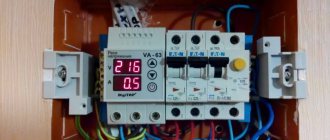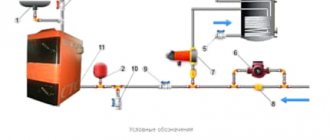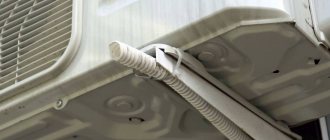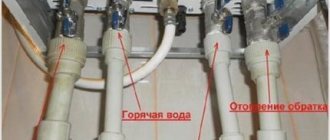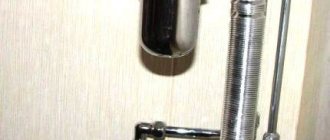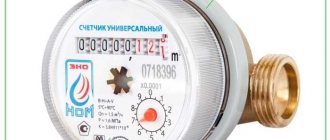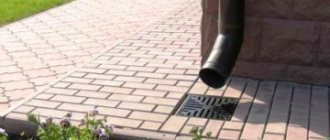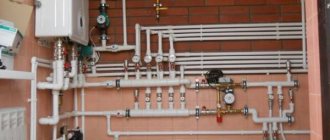Plumbing emergencies are every homeowner’s worst nightmare. Whether in a house or an apartment, it is equally unpleasant and costly. Only in the case of an apartment does the need for conversations with neighbors below and the costs of eliminating their damages add up. But here the situation is better in the sense that even if you are not at home, the neighbors below will turn off the water as soon as they notice signs of a flood. In the case of a private house, equipment that threatens to leak is usually located in rarely visited places - in basements, specially equipped pits. While the owner decides to visit the equipment, he can come to the pool. To avoid such situations, protection against water leaks is necessary. Although this equipment is not cheap, it is becoming increasingly popular. The costs of purchasing and installing it are several times less than the losses that a flood could cause.
To avoid such a situation and install protection against water leaks
What is anti-flood and how does protection against water leaks work?
The anti-flood system consists of several elements: water presence sensors, electrically controlled taps or valves, and a control unit. Sensors for monitoring the presence of water are placed in places where leaks are most likely. Electric taps are placed on risers with water in key places in the water supply and heating systems - in order to minimize the amount of spilled water in the event of an accident. Crane drives and sensors are connected to the monitoring and control unit (controller). It processes signals from sensors and, in the event of an emergency signal, supplies power to the taps. They operate by blocking the flow of water/coolant. Here, in a nutshell, is how water leak protection works.
Protection against water leakage consists of three components: water sensors, electric taps and a controller that controls it all
These systems are installed both for water supply - hot and cold, and for heating. After all, an accident in the heating system is probably even worse than in a water supply system - hotter water causes more damage and can also cause serious burns. In general, for flood protection to be effective, you need to think carefully about the installation locations of sensors and taps.
Device classification
- By the number of secondary protective devices at the facility (emergency shut-off valves with electromagnetic drive). Leakage sensors should not shut off all water supplies if shut-off systems are distributed among consumers. Only the line on which a leak is detected is localized.
- According to the method of submitting information about a water supply (heating system) accident. Local alarm assumes that people are present at the site. Remotely transmitted information is organized taking into account the prompt arrival of the owner or repair team. Otherwise, it is useless.
- Notification method: local sound or light alarm (on each sensor), or output of information to a single remote control.
- Protection against false positives. Typically, finely tuned sensors perform more efficiently.
- Mechanical or electrical protection. An example of mechanics is the Aqua Stop system on the supply hoses of washing machines. There is no alarm on such devices, the scope of application is limited. Self-production is impossible.
Where to place the sensors
Since protection against water leaks is designed to protect against flooding, sensors must be placed in all places where water is most likely to appear. It often happens that the system operates with a delay precisely because of incorrectly selected sensor locations. By the time the water reached the sensor, a lot of it spilled out. Based on the experience of the owners, we can recommend the following places for installing water leakage sensors:
- Under each flexible hose. This is where emergencies most often occur.
- Under household appliances that use water during operation: dishwasher, washing machine. Please note: you need to slide the sensor under the device. Those. install not next to it, but under it.
- Catchment points are the lowest points where water will flow first.
Wired and wireless sensors are the basis of the anti-flood system - Under the boiler, heating boiler, next to the pumping station, in the pit where the pump is installed.
- Under the radiator, heated towel rail.
- Next to (under) the bath, shower, sink, toilet.
When installing water leakage sensors, try to position them so that water hits them first. For example, to control a faucet in the kitchen, you need to place the sensor not under the cabinet, but in the cabinet - under the siphon or somewhere in that area. If something happens to the supply to the faucet, the water will first be in the cabinet and only then flow under it.
If you need to monitor leaks in household appliances—a washing machine, a dishwasher—place sensors under the appliances. Not next to, but directly next to the connection point of the drain hose.
Where to install taps/valves with electric drive
Installing faucets is not easy. Specific installation locations depend on the system design. If it is a small apartment with one or two risers - cold and hot water - everything is simple. We close off the outlets and that’s it. In more complex systems, it is necessary to think about the installation location of electric cranes.
The placement of shut-off valves depends on the system design
In apartments
If the water supply is centralized, the system’s leakage valves are placed at the entrance to the apartment/house. It is much better if the taps are located before the meter and filter. But operational services may disagree with this arrangement. They usually require that the electric faucet be located after the meter. In this case, if there is a leak, the connection between the meter and the filter always remains under pressure. It will be impossible to eliminate leaks at these points. You can insist on your point, but you have to prove your point of view.
Advice! Before installing a leakage protection system, contact your management company and find out whether there will be problems when sealing meters if electric taps are installed in front of them.
In some layouts, the apartment may have four risers - two cold and two warm water. In this case, there are two solutions - a more correct one and a more economical one. That's right - install two modules, each of which will serve its own zone. This is more convenient, since an accident will occur only on one of the risers/devices and it is unreasonable to disconnect the opposite part. But two modules mean double costs. To save money, you can install one control unit that will shut off the taps for 4 risers. But in this case, do not forget that you will have to run the wires through the entire apartment.
We need to think about where to install the system elements
In the case of heating, too, not everything is simple. Most high-rise buildings have vertical wiring. This is when there is a riser in each (or almost every) room and one or two radiators are powered from it. It turns out that for each outlet it is necessary to install at least one tap - for supply. But then the water contained in the radiator and pipes will leak out. This, of course, is not so much, but sometimes a couple of liters is enough for the neighbors below to have a stain on the ceiling. On the other hand, installing two taps on each radiator is too expensive.
In a private house
To prevent the pump from pumping water in the event of an accident, it is necessary to use a water leakage protection controller with a power relay. If power is supplied to the pump through the contacts of this relay, simultaneously with the signal to close the ball valves or valves, the power to the pump will be turned off. Why not just turn off the power to the pump? Because in this case, all the water that is in the system can spill into the resulting gap. And this is usually a lot.
To understand in which places in the water supply system of a private home it is necessary to install taps to prevent water leaks, you need to study the diagram. Most often, shut-off valves with electric drives are installed after the pumping station and on the boiler.
Protection against water leakage can be included in the kit, or you can assemble your own configuration from components
Heating is a little more complicated. You should not block the flow of coolant if it is impossible to immediately extinguish the boiler. That is, in systems with solid fuel boilers, water leakage control can be installed only if it does not block the circulation of the coolant. If there is a small circulation circuit, you can install valves so that this small circuit is running while the rest of the system is turned off. If a heat accumulator is installed in the system, it is necessary to install the taps so that water does not spill out of it. These are large-volume containers - at least 500 liters, and usually many times more. If all the liquid spills out, it won't seem like much.
In heating systems with automated boilers, taps may block circulation. If the water leakage protection works and blocks the circulation, the boiler will stop due to overheating. This is not a completely normal situation, but it is not an emergency either.
Some technical points
Wired sensors usually come with 2 meter cables. Electric ball valves are also sold with the same cable length. This is not always enough. You can increase the length using a cable recommended by the manufacturer. Brands are usually indicated in the instruction manual. Just check the cross-section of the cores when purchasing. Unfortunately, very often the actual diameter is much smaller than the declared one.
Generally speaking, we can recommend the following cables for extension:
- for wired sensors, a shielded twisted pair with a core cross-section of at least 0.35 mm² is suitable;
- for cranes - power cable in two-layer insulation with a core cross-section of at least 0.75 mm².
The correct arrangement of elements is not always obvious.
It is advisable to make the connection serviceable. That is, if you are laying wires in a wall or floor, the connection must be made in a junction box. Connection method - any, reliable (soldering, contactors of any type since the equipment is low-current). It is better to lay wires in walls or floors in cable ducts or pipes. In this case, it will be possible to replace the damaged cable without opening the gate.
Protection against water leaks: parameters and selection criteria
Deciding on the number of sensors and shut-off valves is not so difficult, especially since many systems easily allow you to expand the control area. It is only important not to exceed the maximum allowable amount of equipment. But choosing a manufacturer is much more difficult - you can’t change it. Below we will present the most popular systems on the Russian market: “Aquastorozh”, “Neptune” and “Gidrolok”.
Nutrition
First, let's look at how power is supplied to different parts of the flood protection system:
- The voltage on the control unit must be constant.
- Electrically driven faucets are powered only for the period of operation - maximum - 2 minutes (Hydrolock).
- For wired type sensors - only for the period of status polling (a very short period of time).
- Wireless sensors operate on batteries.
Water leakage protection can operate on 220V, 12V and 4.5V. Generally speaking, the safest supply is 12V or lower.
Power types
Some systems are designed in such a way that the control unit is powered by 220 V, and a safe voltage of 12 V or less is supplied to the electric taps and sensors. In other options, 220 V can be supplied to the taps (some of the Neptune options). Voltage is supplied briefly - only at the moment when it is necessary to turn off the water. This occurs after an accident is detected and periodically to check and maintain the functionality of the system. The rest of the time the taps are de-energized. Which option suits you best is up to you to decide.
Also pay attention to the presence of a backup power source. If you have your own redundant power supply system (batteries, generator), this parameter can be omitted. Otherwise, having a backup power source is highly desirable. Moreover, we need to look at how long the equipment can operate in autonomous mode. In this sense, systems operating from 12 V are much more practical: if you wish, you can install a battery with suitable parameters and thereby extend the system’s operation in offline mode. Although, some systems (Hydrolock, for example) on backup power (rechargeable batteries) can operate for up to a year. During this time the electricity will definitely be turned on...
Electric cranes: which ones are better?
Let’s say right away that there is protection against water leaks based on valves and ball valves. Ball valves are more reliable. They are more expensive, but they work many times more reliably. When choosing, take the one with ball valves that shut off the water, not valves. There are no options.
But ball valves are also different. Here are the requirements they must meet:
- Made from brass or stainless steel. These metals should be used for housings, rods and locking balls. Only in this case will they serve for a long time.
- Full bore valves. This means that when open, the cross-section of the valve is no less than the cross-section of the pipe on which it is installed. In this case, they do not interfere with the flow.
Neptune ball valves can be recognized by the presence of a lever that allows you to easily shut off the water manually.
All market leaders - Aquawatch, Hydrolock and Neptune - use only such valves. They can be produced by different companies, but are made of high-quality metal. If the cheaper kits don't specify the material or type of faucet (full bore or not), look elsewhere.
Durability and closing time
We also need to talk about the parameters of electric drives. How reliable and durable they are determines how reliable the protection against water leaks is and how efficient the system is. Therefore, the gearbox and drive gears must be made of durable and reliable material. The most durable material that can be used here is metal. If we talk about the most well-known systems, the following situation is observed on this point:
- In the Hydrolock system, gearboxes and gears are made of metal.
- In Aquawatch, the gears are made of metal in the latest versions of the system, the gearbox remains plastic.
- Neptune does not cover drive materials.
Another important characteristic is the closing time of ball valves. In theory, the sooner the water supply is shut off in an emergency, the better. Here the undisputed leader is Aquaguard - the ball valves close in 2.5-3 seconds. But this speed is achieved:
- installing additional gaskets, which reduces ball friction but increases the risk of leaks;
- a small torque, and a small force applied when closing the tap can result in the fact that if a foreign object (sand, scale, etc.) gets in or is overgrown with salts, the tap simply will not close.
Electric ball crane "Aquastorozh Expert-20". Input voltage 4.5 to 5.5 V
Closing force and manual mode
If we talk about the magnitude of torque, the leader here is protection against water leaks Hydrolock. Its electric drives can develop a force of up to 450 kg/m. This is a very large indicator, but these parameters are for large-section cranes, which are not used in apartments and houses. Nevertheless, half-inch and inch ones are also very powerful - they can develop a force of up to 100 kg/m. Moreover, the applied force increases in steps - if necessary, it increases from nominal to maximum.
And this is Gidrolok’s signature trick - the crane breaks a pencil... Impressive!
There is one more point: the ability to turn off the electric tap manually. Aquawatch and Hydrolock have parity in this regard: you need to remove the drive by unscrewing several bolts (for Hydrolock - 2, for Aquawatch - 4), then manually turn the tap. Neptune is ahead in this regard: its drives have a lever, by turning which you manually open or close the water. But these faucets are included with the most expensive of the kits.
Neptun Bugatti Pro 12 B 1/2″ faucet with lever on the body. If the drive housing is green, then the power supply is 12 Volts. Taps designed for 220 Volts have a blue drive housing
Electric crane Neptun Bugatti Pro 220V 3/4 N-30
Features of the operating algorithm
The principle of operation of any protection against water leakage is the same: when an emergency signal appears, it shuts off the water supply and turns on the alarm. In this all systems are similar, but there are certain features that some like and others don’t.
The first feature is related to the processing of signals from sensors and taps. Some systems monitor the integrity of the wires that go to faucets and wired sensors. In addition, if wireless sensors are present, they are polled regularly. This is all great and such systems are more reliable, but the reaction to a “missing” sensor or faulty wire can be different:
- on the Hydrolock control panel, the alarm for loss of sensors or faulty taps lights up, but the water does not turn off;
- If any of the sensors or taps are lost, the water watchman shuts off the water;
- at Neptune, only the response of the sensors is monitored and, based on the results, an alarm lights up without specifying the location.
Here everyone chooses for themselves which option suits them best. Both ways of reacting are imperfect, so there is no single answer.
There are subtleties in the operating algorithms
The second parameter for choosing a leakage protection system is the frequency of checking the functionality of the taps. Since our water is far from being of the best quality, if it is not used for a long time, the shut-off ball can become “overgrown” with salts or, as they say, “stick.” To prevent this from happening, the controllers periodically “move” the taps. The frequency varies:
- protection against water leaks Gidrolock (Gidrolock) tests once a week;
- any Aquaguard controller turns the ball valves once every two weeks;
- Some Neptune options do not have this function; there are those that open/close taps once every two weeks.
Some fear that testing the functionality of the faucets will catch them in the shower. Of course, it’s not pleasant to be soaped without water, but none of the owners have ever complained about such cases. So it's not nearly as dangerous as it seems))
How to choose
The first selection criterion is the tap locking speed. If the consumer chooses the Neptune budget system, then the taps are closed in 30 seconds. But expensive analogues (Aquawatch, Aquastop) will stop the water supply after 2-3 seconds. The protective circuit must be selected depending on the volume. According to calculations, in the first 30 seconds after a pipe rupture, about 20–25 liters of water spill out.
Most protection circuits monitor sensors themselves. If there is a loss of battery charge, the solenoid valves are cleaned automatically. Human intervention will only be required in the event of an accident.
Some features of popular systems
In order to somehow highlight their protection against water leaks, manufacturers are trying to improve reliability or come up with other moves. It is impossible to systematize these features, but it is better to know about them when choosing.
Capabilities of one block
For different manufacturers, one control unit can control a different number of devices. So it won't hurt to know this.
- One Hydrolock controller can service a large number of wired or wireless sensors (200 and 100 pieces, respectively) and up to 20 ball valves. This is great - at any time you can install additional sensors or install several more cranes, but such a reserve of capacity is not always in demand.
- One Akastorozh controller can service up to 12 wired sensors. To connect wireless, you need to install an additional unit (designed for 8 Aquawatch Radio pieces). To increase the number of wired ones, install another module. This modular expansion is more pragmatic.
- Neptune has control units of different powers. The most inexpensive and simple ones are designed for 2 or 4 taps, for 5 or 10 wired sensors. But they do not check the functionality of the taps and do not have a backup power source.
As you can see, everyone's approach is different. And these are just the leaders. There are even smaller campaigns and Chinese companies (where would we be without them) that either repeat one of the above plans or combine several.
Additional functions
Additional ones are not always unnecessary. For example, for those who are often on the road, the ability to control cranes from a distance is far from superfluous.
- Gidrolok and Akvatorozh have the ability to turn off water remotely. For this purpose, a special button is placed at the front door. Go out for a long time - press and turn off the water. Aquawatch has such a button in two versions: radio and wired. Gidrolok has only wired ones. The Aquastore radio button can be used to determine the “visibility” of the wireless sensor installation location.
- Hydrolock, Akvastorozh and some Neptune variants can send signals to the dispatch service, security and fire alarm systems, and can be built into the “smart home” system.
- Hydrolock and Akvastorozh check the integrity of the wiring to the taps and their position (some systems, not all). In Hydrolock, the position of the locking ball is controlled by an optical sensor. That is, when checking there is no voltage in the tap. The Aqua Watchman has a contact pair, that is, at the time of testing, voltage is present. Protection against water leaks Neptune also monitors the position of the taps using a contact pair.
The hydrolock can be controlled using a GSM module - via SMS (commands to turn on and off). Also, in the form of text messages, signals about accidents and “disappearances” of sensors, broken cables to electric taps and malfunctions can be sent to the phone.
Always being aware of the condition of your home is a useful option.
On the issue of reliability: power supply and other issues
Reliable operation does not only depend on the reliability of the cranes and controllers. Much depends on the power supply, on how long each unit can operate autonomously.
- Aquawatch and Hydrolock have backup power sources. Both systems shut off the water before the backup power supply is completely discharged. Neptune has batteries only for the last two models of controllers, and then the taps do not close when discharged. The rest - earlier and less expensive models - have a 220 V power supply and no protection.
- Neptune's wireless sensors operate at a frequency of 433 kHz. It happens that the control unit “does not see” them through the partitions.
- If the batteries in the Gidroloka wireless sensor run out, the alarm on the controller lights up, but the taps do not close. The signal is generated several weeks before the battery is completely discharged, so there is time to change it. In a similar situation, the Aqua Watchman shuts off the water. By the way, the Hydrolock battery is soldered. So changing it is not so easy.
- Aquawatch has a lifetime warranty on any sensors.
- Neptune has wired sensors that are installed flush with the finishing material.
We looked at all the features of the three most popular manufacturers of water leakage protection systems. In short, the worst thing about the Aquawatch is the plastic gearbox on the drive; the worst thing about the Hydrolock is the high power of the system and, accordingly, the price. Neptune - inexpensive systems are powered by 220 V, do not have a backup power source and do not check the functionality of the taps.
Naturally, there are Chinese leakage protection systems, but you should choose them with caution.
What types of SPPV are there?
Systems differ in:
- power supply method - from batteries, accumulator or mains;
- installation methods - some are installed during repairs, others can be installed after completion;
- type of valves - ball, ceramic, etc.;
- type and power of electric drives;
- type of sensors - wired and wireless;
- a set of additional functions - monitoring the status of batteries and taps, notification of events to the phone, remote control, etc.
Neptune
Hydrolock
Aqua guard
They offer options for apartments, country houses, offices and other premises. The basic set can be expanded with additional equipment.
System "Neptune"
It is produced in 4 versions. Prices for ready-made kits range from 9,670 rubles. up to 25900 rub.
Wired system Neptune Aquacontrol
for an apartment it has two 1/2" taps (or two 3/4" taps), two sensors connected by 0.5 m long wires to the base control module. This module closes and opens taps once a month, even if there is no leakage, to prevent them from souring. The system is powered from a 220 V network (there is no backup power source), the taps close 18 seconds after water hits the sensor. It is recommended to install it during repairs, since electrical wiring needs to be installed. 6 taps and 20 sensors can be connected to the control module. The warranty period is 4 years.
Wired system Neptune Base
has 3 sensors with 2 m electrical cords, two Italian Bugatti taps 1/2 or 3/4 inches, a basic control module. The crane motors operate no later than after 21 seconds and are powered by a 220 V network (there is also no backup power source). Recommended for apartments. Installation during renovation. The warranty period is 6 years.
Wired system Neptune Pro
differs from previous models in the control unit, which allows it to be integrated into third-party warning systems (dispatching, smart home, security systems), and the presence of a backup power source. Suitable not only for an apartment, but also for a cottage. 6 year warranty.
Wireless system Neptune Bugatti Pro+
— the latest development of the manufacturer’s designers. The system is equipped with two radio sensors, but 31 radio sensors or 375 wired sensors, as well as 4 taps, can be connected to it. Radio sensors operate at a distance of up to 50 m from the control module. When connected via a router, the signal reception range increases. Installed both during and after repairs. Suitable for large cottages with many possible water leaks. 6 year warranty.
GIDROLOCK systems
Operates on AA batteries. Options have been developed for use in apartments, country houses and cottages. More than 30 modifications are presented, taking into account the type of water supply - hot or cold individual or centralized, pipe diameter - 1/2, 3/4, 1, 1 1/4, 2 inches, room area and so on. The control unit monitors the performance of the sensors.
The control unit of the GIDROLOCK PREMIUM system is connected to 200 wired sensors, 20 ball valves, 100 radio sensors and a GSM alarm system that notifies about an accident via SMS message to the phone. The electric drive closes the tap within 12 seconds from the moment the signal about a leak is received.
There is manual control of the position of the ball valve. It will be needed when there is no time to wait for the sensor to dry before opening the water, or if you need to turn off the water when no accident has occurred. For example, when replacing a valve in the kitchen. To do this, remove the metal clamp and turn the electric drive housing to close the tap. Open with a reverse motion.
The manufacturer offers kits for apartments and country houses with autonomous and centralized water supply. The electric drive housing is detachable from the ball valve, which simplifies the installation of the ball valve on the pipe.
System "Aquawatch"
It is positioned as the world's first flood protection system with triple power: from batteries, a universal network mini-USB adapter and a built-in uninterruptible power supply. It accumulates energy and ensures the operation of the system when the batteries are dead and/or when there is a power outage in the apartment. The system detects a damaged or lost sensor and gives a signal to turn off the taps.
The Autowatch-Expert model has the ability to integrate into the Smart Home system and connect a GSM module for SMS alerts.

